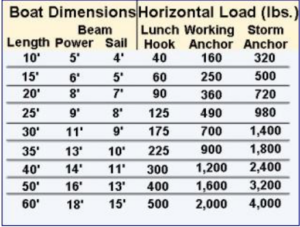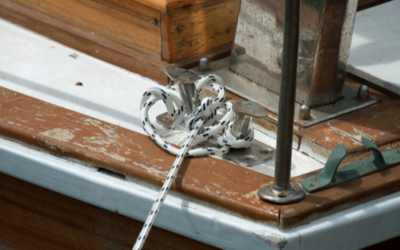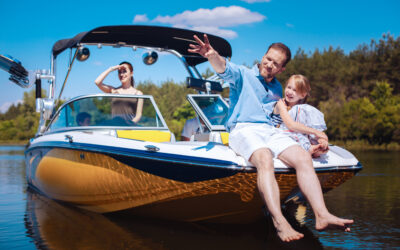Why are anchors so important? Aren’t they just another part of the boat? Anchors are actually considered an essential piece of safety gear. It can not only hold your boat in place as you decide to drop anchor and go exploring for a few hours, but If your boat engine fails, a well-set anchor will keep wind or current from drifting your disabled boat onto a shoal or ashore, where it could be damaged.
The first step in anchoring your boat is determining the water depth where you want to drop anchor. The water depth will determine the correct amount of anchor scope required. A 7:1 ratio is recommended—seven feet of scope to one foot of water depth. Lower the anchor and let out enough scope, then secure the rope to a bow cleat. Then, either let the wind or current carry you back 70 feet, or move the boat in reverse that distance if there is no wind or current to set the anchor on the bottom.
Ensure there is no drag—use landmarks or onboard electronics to measure movement. If needed, reset the anchor. You want to make sure that the anchor is set and not dragging on the bottom. You can sight on two landmarks on shore, or use electronics such as GPS, a chart plotter, or a depth finder to sound an alarm if the boat is moving. If the wind, current or tide changes and causes the boat to swing over the anchor, it may reset itself on the bottom. If it does not you’ll need to re-set the anchor. It’s important to stay vigilant at all times when anchored.
To retrieve the anchor, slowly motor toward the anchor while pulling in the rope. When you are directly over the anchor it should pull free. If it’s stuck, first try slowly turning the boat in a large circle to change the direction of pull on the rope. Another method is to pull up rode until the boat is directly over the anchor, and then give the line a turn around a cleat. Pull it taut as the bow dips in the bottom of a wave, and when the next wave lifts the boat it may break the anchor free.
Remember, never tie off an anchor to the stern of a boat or try to pull up a stuck anchor by pulling with the engine after securing the rode to a stern cleat. You may actually pull the stern low enough to swamp the boat—water may come over the stern and fill the boat—resulting in a very dangerous situation. If you can’t release a stuck anchor, it’s best to simply cut the line and replace the anchor.
There are several anchors on the market but the two most common types of anchors used for pleasure boats are the fluke (also called a Danforth) and the plow, or scoop. The fluke anchor is popular for small to medium-sized boats because its lightweight and folds flat, making it easy to handle and store. The unique shape of the claw allows a 360 degree turn without breaking out. Curved flukes make it easier for a claw to right itself no matter how it lands on the bottom, or how much the boat gets swung around. It offers excellent holding power in a sand or muddy bottom, but it’s not as effective in a rocky bottom.
The plow-style anchor is more common on heavier boats and holds well in most bottom conditions. When dropped in the water, a plow lands on its side, then when pulled, buries itself. Its shape allows it to reset fairly easily should the wind or tide shift the boat position. It also usually resets itself if the wind shifts. It doesn’t fold and is usually heavier than the fluke anchor, so it’s best-suited to boats with a bow roller and windlass, rather than an anchor locker. The anchor is connected to the boat with the rode; on most family powerboats the rode includes a length of chain at the anchor end and nylon line (rope) from the chain to the boat.
Your boats’ size, weight and design characteristics affect what kind of anchor you will need to use. According to the Boat U.S. Foundation (Boat Owner’s Association of the United States), a 10,000 pound boat may only require an anchor with a holding power of a few hundred pounds on a calm day, but may need 1,000 pounds of holding power or more on a stormy day. In another example, a 30 foot 10,000 pound houseboat needs a larger anchor than a 30 foot 6,000 pound speedboat. 
Where you plan to anchor often dictates what type of anchor you should use. Is the bottom rock, or is it soft mud? If you are not familiar with the area, ask around or look at a local chart. Anchoring in a calm protected cove can be quite different than anchoring offshore or on a large open bay. And finally, don’t forget the weather–high winds, tides and waves can all make anchoring difficult, if not impossible.
If you’re unsure of the appropriate size of anchor you need for your boat, use the anchor manufacturer guidance to determine which size anchor is appropriate. Anchors are rated by “holding power”, which is the ability of an anchor to hold a given weight.
Learning how to anchor a boat is a basic seamanship skill that every boater should master, even if you don’t anticipate anchoring very often. Understanding how to set the anchor and retrieve an anchor is critical.
For more boat safety tips, read our blog on Proper Boat Trailer Tire Pressure.



